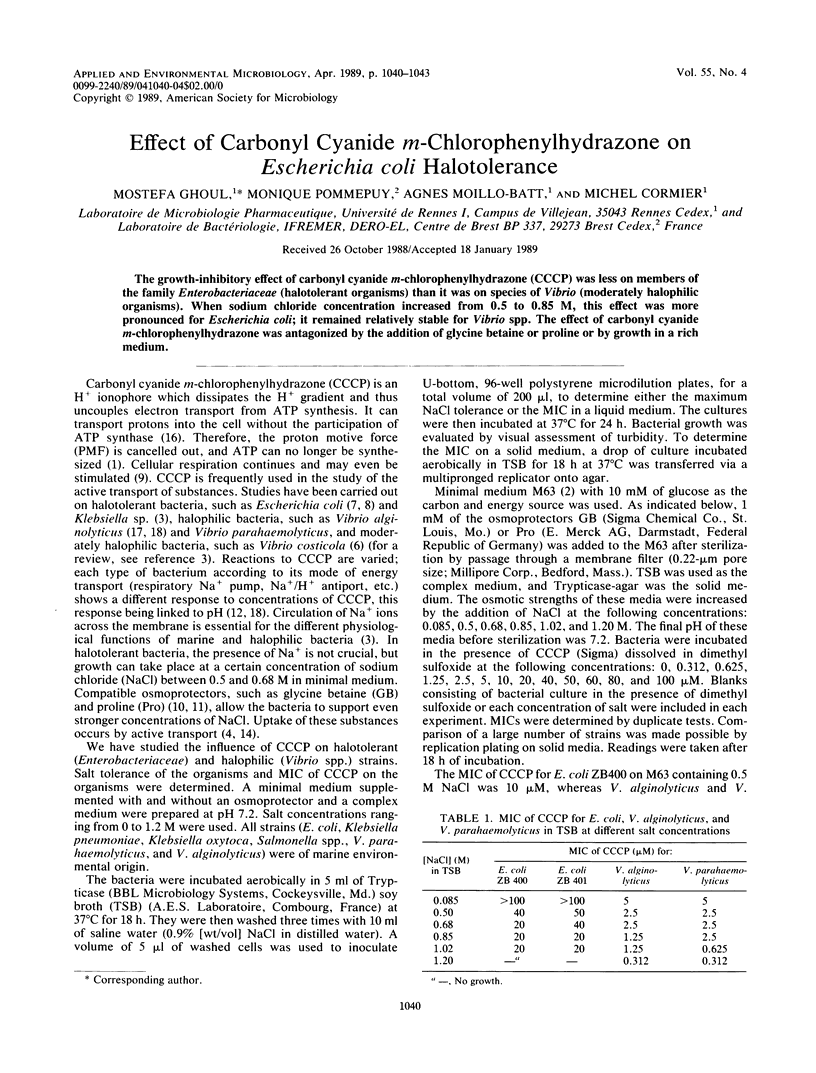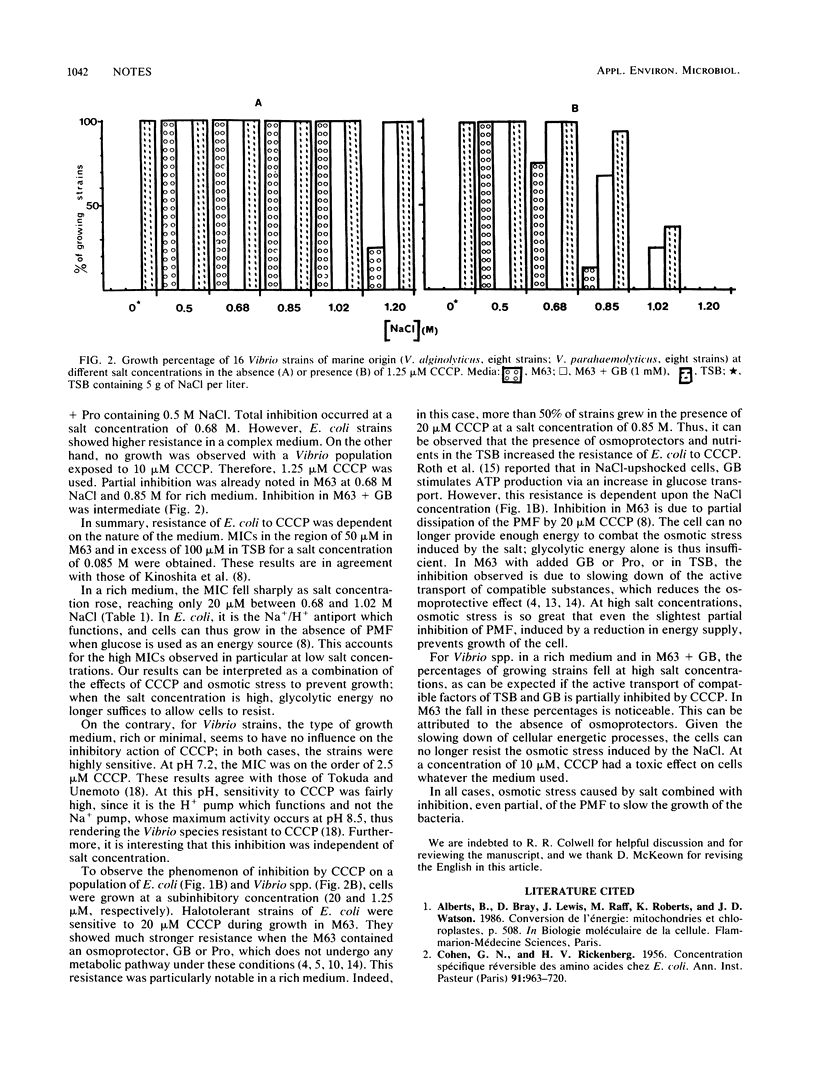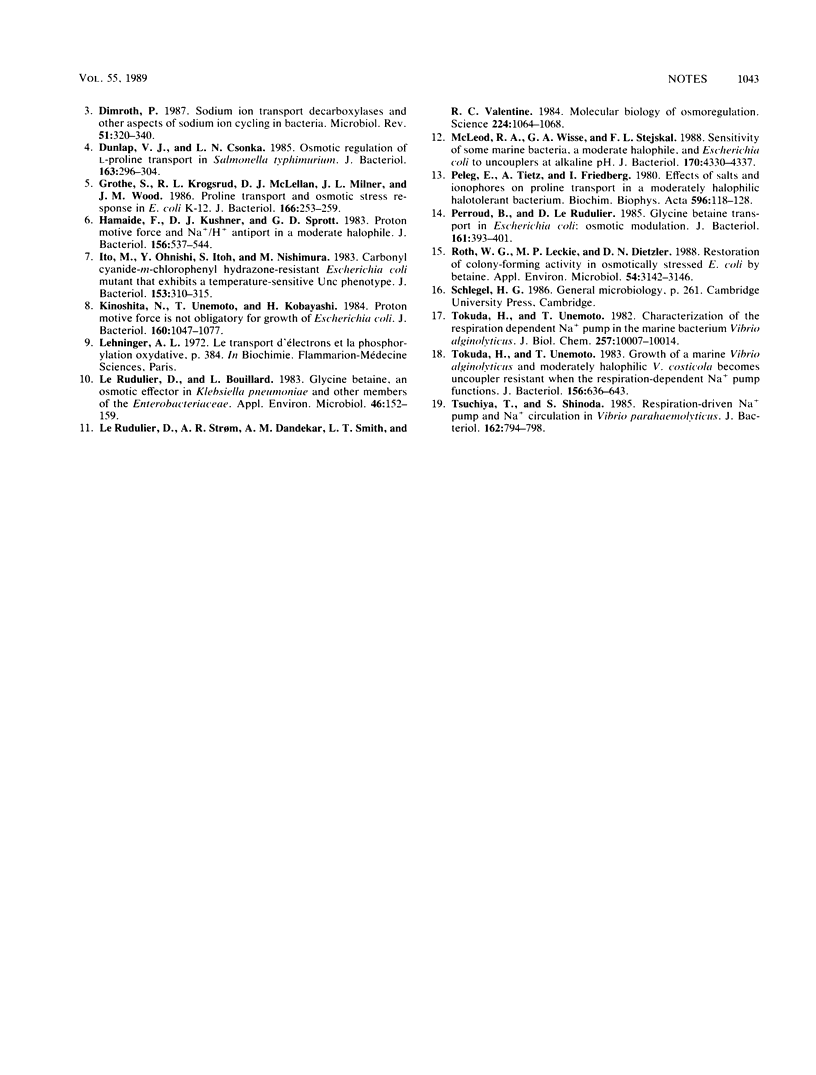Abstract
The growth-inhibitory effect of carbonyl cyanide m-chlorophenylhydrazone (CCCP) was less on members of the family Enterobacteriaceae (halotolerant organisms) than it was on species of Vibrio (moderately halophilic organisms). When sodium chloride concentration increased from 0.5 to 0.85 M, this effect was more pronounced for Escherichia coli; it remained relatively stable for Vibrio spp. The effect of carbonyl cyanide m-chlorophenylhydrazone was antagonized by the addition of glycine betaine or proline or by growth in a rich medium.
Full text
PDF



Selected References
These references are in PubMed. This may not be the complete list of references from this article.
- COHEN G. N., RICKENBERG H. V. Concentration spécifique réversible des amino acides chez Escherichia coli. Ann Inst Pasteur (Paris) 1956 Nov;91(5):693–720. [PubMed] [Google Scholar]
- Dimroth P. Sodium ion transport decarboxylases and other aspects of sodium ion cycling in bacteria. Microbiol Rev. 1987 Sep;51(3):320–340. doi: 10.1128/mr.51.3.320-340.1987. [DOI] [PMC free article] [PubMed] [Google Scholar]
- Dunlap V. J., Csonka L. N. Osmotic regulation of L-proline transport in Salmonella typhimurium. J Bacteriol. 1985 Jul;163(1):296–304. doi: 10.1128/jb.163.1.296-304.1985. [DOI] [PMC free article] [PubMed] [Google Scholar]
- Grothe S., Krogsrud R. L., McClellan D. J., Milner J. L., Wood J. M. Proline transport and osmotic stress response in Escherichia coli K-12. J Bacteriol. 1986 Apr;166(1):253–259. doi: 10.1128/jb.166.1.253-259.1986. [DOI] [PMC free article] [PubMed] [Google Scholar]
- Hamaide F., Kushner D. J., Sprott G. D. Proton motive force and Na+/H+ antiport in a moderate halophile. J Bacteriol. 1983 Nov;156(2):537–544. doi: 10.1128/jb.156.2.537-544.1983. [DOI] [PMC free article] [PubMed] [Google Scholar]
- Ito M., Ohnishi Y., Itoh S., Nishimura M. Carbonyl cyanide-m-chlorophenyl hydrazone-resistant Escherichia coli mutant that exhibits a temperature-sensitive unc phenotype. J Bacteriol. 1983 Jan;153(1):310–315. doi: 10.1128/jb.153.1.310-315.1983. [DOI] [PMC free article] [PubMed] [Google Scholar]
- Kinoshita N., Unemoto T., Kobayashi H. Proton motive force is not obligatory for growth of Escherichia coli. J Bacteriol. 1984 Dec;160(3):1074–1077. doi: 10.1128/jb.160.3.1074-1077.1984. [DOI] [PMC free article] [PubMed] [Google Scholar]
- Le Rudulier D., Bouillard L. Glycine betaine, an osmotic effector in Klebsiella pneumoniae and other members of the Enterobacteriaceae. Appl Environ Microbiol. 1983 Jul;46(1):152–159. doi: 10.1128/aem.46.1.152-159.1983. [DOI] [PMC free article] [PubMed] [Google Scholar]
- Le Rudulier D., Strom A. R., Dandekar A. M., Smith L. T., Valentine R. C. Molecular biology of osmoregulation. Science. 1984 Jun 8;224(4653):1064–1068. doi: 10.1126/science.224.4653.1064. [DOI] [PubMed] [Google Scholar]
- MacLeod R. A., Wisse G. A., Stejskal F. L. Sensitivity of some marine bacteria, a moderate halophile, and Escherichia coli to uncouplers at alkaline pH. J Bacteriol. 1988 Sep;170(9):4330–4337. doi: 10.1128/jb.170.9.4330-4337.1988. [DOI] [PMC free article] [PubMed] [Google Scholar]
- Peleg E., Tietz A., Friedberg I. Effects of salts and ionophores on proline transport in a moderately halopholic halotolerant bacterium. Biochim Biophys Acta. 1980 Feb 15;596(1):118–128. doi: 10.1016/0005-2736(80)90175-3. [DOI] [PubMed] [Google Scholar]
- Perroud B., Le Rudulier D. Glycine betaine transport in Escherichia coli: osmotic modulation. J Bacteriol. 1985 Jan;161(1):393–401. doi: 10.1128/jb.161.1.393-401.1985. [DOI] [PMC free article] [PubMed] [Google Scholar]
- Roth W. G., Leckie M. P., Dietzler D. N. Restoration of colony-forming activity in osmotically stressed Escherichia coli by betaine. Appl Environ Microbiol. 1988 Dec;54(12):3142–3146. doi: 10.1128/aem.54.12.3142-3146.1988. [DOI] [PMC free article] [PubMed] [Google Scholar]
- Tokuda H., Unemoto T. Characterization of the respiration-dependent Na+ pump in the marine bacterium Vibrio alginolyticus. J Biol Chem. 1982 Sep 10;257(17):10007–10014. [PubMed] [Google Scholar]
- Tokuda H., Unemoto T. Growth of a marine Vibrio alginolyticus and moderately halophilic V. costicola becomes uncoupler resistant when the respiration-dependent Na+ pump functions. J Bacteriol. 1983 Nov;156(2):636–643. doi: 10.1128/jb.156.2.636-643.1983. [DOI] [PMC free article] [PubMed] [Google Scholar]
- Tsuchiya T., Shinoda S. Respiration-driven Na+ pump and Na+ circulation in Vibrio parahaemolyticus. J Bacteriol. 1985 May;162(2):794–798. doi: 10.1128/jb.162.2.794-798.1985. [DOI] [PMC free article] [PubMed] [Google Scholar]


